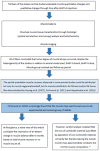High Precision Use of Botulinum Toxin Type A (BONT-A) in Aesthetics Based on Muscle Atrophy, Is Muscular Architecture Reprogramming a Possibility? A Systematic Review of Literature on Muscle Atrophy after BoNT-A Injections
- PMID: 35202109
- PMCID: PMC8878196
- DOI: 10.3390/toxins14020081
High Precision Use of Botulinum Toxin Type A (BONT-A) in Aesthetics Based on Muscle Atrophy, Is Muscular Architecture Reprogramming a Possibility? A Systematic Review of Literature on Muscle Atrophy after BoNT-A Injections
Abstract
Improvements in Botulinum toxin type-A (BoNT-A) aesthetic treatments have been jeopardized by the simplistic statement: "BoNT-A treats wrinkles". BoNT-A monotherapy relating to wrinkles is, at least, questionable. The BoNT-A mechanism of action is presynaptic cholinergic nerve terminals blockage, causing paralysis and subsequent muscle atrophy. Understanding the real BoNT-A mechanism of action clarifies misconceptions that impact the way scientific productions on the subject are designed, the way aesthetics treatments are proposed, and how limited the results are when the focus is only on wrinkle softening. We designed a systematic review on BoNT-A and muscle atrophy that could enlighten new approaches for aesthetics purposes. A systematic review, targeting articles investigating BoNT-A injection and its correlation to muscle atrophy in animals or humans, filtered 30 publications released before 15 May 2020 in accordance with the Preferred Reporting Items for Systematic Reviews and Meta-Analyses (PRISMA) guidelines. Histologic analysis and histochemistry showed muscle atrophy with fibrosis, necrosis, and an increase in the number of perimysial fat cells in animal and human models; this was also confirmed by imaging studies. A significant muscle balance reduction of 18% to 60% after single or seriated BoNT-A injections were observed in 9 out of 10 animal studies. Genetic alterations related to muscle atrophy were analyzed by five studies and showed how much impact a single BoNT-A injection can cause on a molecular basis. Seriated or single BoNT-A muscle injections can cause real muscle atrophy on a short or long-term basis, in animal models and in humans. Theoretically, muscular architecture reprogramming is a possible new approach in aesthetics.
Keywords: aesthelics; botox; botulinum toxins; esthetics; ficial lines; muscle atrophy; muscular architecture reprogramming; muscular atrophy; type A; wrinkles.
Conflict of interest statement
The authors declare no conflict of interest.
Figures




References
-
- Ministério da Saúde Consultoria Jurídica/Advocacia Geral da União 1 Nota Técnica N° Nota Técnica N°342/2014. [(accessed on 28 July 2019)]; Available online: https://portalarquivos2.saude.gov.br/images/pdf/2014/setembro/17/Toxina-....
Publication types
MeSH terms
Substances
LinkOut - more resources
Full Text Sources
Medical

